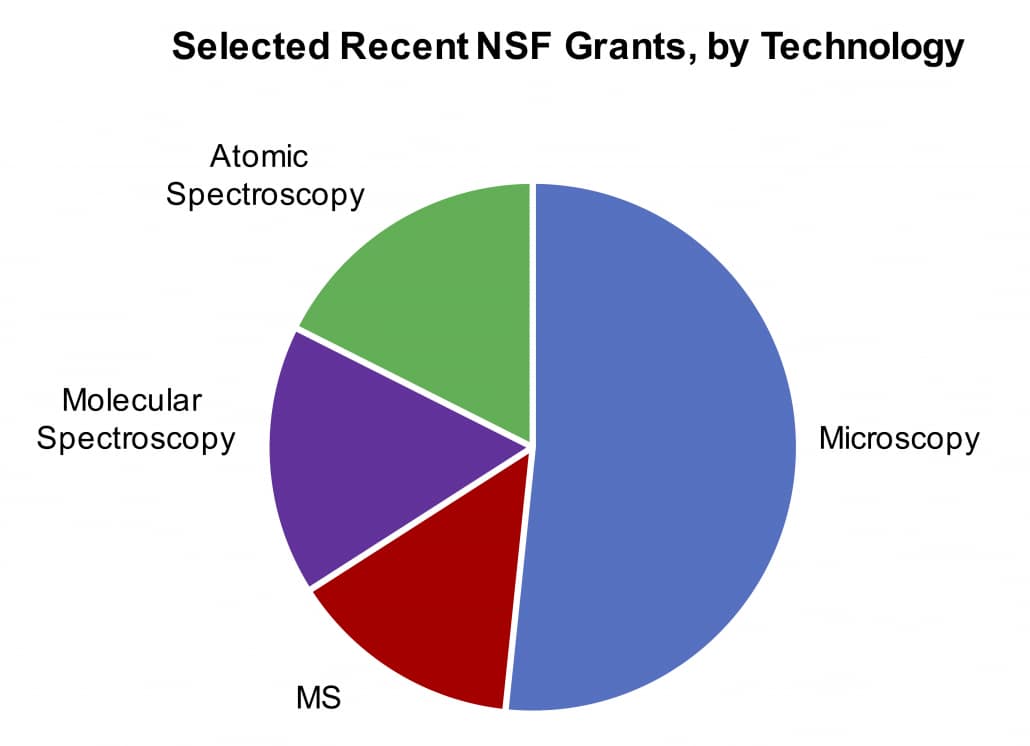NSF Establishes Mid-scale Research Infrastructure Opportunities
The NSF has long supported scientific research instrumentation purchases through funding mechanisms such as the Major Research Instrumentation (MRI) program and the Major Research Equipment and Facilities Construction (MREFC) account, making investing in research infrastructure a key priority over the past 60 years. From macro-based research projects, such as ecosystems and earth studies, to micro-based projects, such as cell and gene studies, the MRI and MREFC programs have fostered infrastructure and instrumentation purchases to enable analytical instrument purchases and infrastructure.
However, the majority of NSF awards that are in the $20–$70 million range are mostly allocated to centers, institutes, and large facility operations and maintenance, with little investments made in mid-scale research and cyber infrastructure. Moreover, the NSF has found that despite the lack of funding for mid-scale projects, there are opportunities for these projects and an extremely strong interest in mid-scale infrastructure across virtually all disciplines. To address this discrepancy, the NSF last month announced that it will begin to provide awards for mid-scale research projects that will include funding for “the creation of mid-scale disciplinary instrumentation to the implementation (including acquisition and construction) of mid-scale facilities.” These opportunities will not only help broaden the scope of scientific research funding, but also potentially result in more instrumentation purchases, infrastructure contracts and international collaborations.
Recent MRI Awards
A dataset summarizing recent NSF MRI awards indicates that the vast majority of awards were granted for the purpose of purchasing or developing surface science instruments. TEM, SEM, AFM, laser scanning confocal and fluorescence microscopes were among the instruments frequently cited by scientists as being imperative to their research, which largely revolved around cells and proteins, as well as genomics and materials characterization.
This overwhelming majority of microscopy purchases by researchers can be attributed to advancements in the speed of detectors that are sensitive to electrons, according to a recent Nature article. Although TEMs have remained generally the same since their development almost 90 years ago, their resolution power has improved by a factor of over one thousand. By the late 2000s, electromagnets were able to correct electron beam distortions reaching sub-angstrom resolution. Additionally, biologists are now able to utilize extremely sensitive “direct-electron detectors,” which became easily accessible in the early years of this decade, and led to the development of the cryo-EM technique, which has advanced biomolecule structure research.
Many recent MRI awards were also used to purchase atomic spectroscopy instruments, such as crystal, powder, microfocus and dual-source XRDs, as well as ICP, IC-ICP-MS and ICP-MS systems, including those that have laser ablation or LC capabilities. Several researchers also utilized awards to purchase TOF systems, including TOF-SIMS, TOF-ICP-MS and MALDI-TOF-TOF platforms. Molecular spectroscopy was also a popular technology, specifically NMRs, with numerous researchers purchasing new NMRs or upgrading NMR consoles.
Restructuring Funding Opportunities
The NSF has supported scientific research through mechanisms such as its MRI program and MREFC program that provide funding for infrastructure and instrumentation. According to the NSF in a recent report, research infrastructure is defined as “any combination of facilities, equipment, instrumentation, computational hardware and software, and the human capital needed for associated support.” However, over the past few years, the research community has discussed the need for a mid-scale mechanism to better enable scientific research that does not require the time and resources of the larger research projects that are funded by the MREFC.
“Mid-scale” is described as pertaining to projects that are between the current maximum limit of the MRI program, which is $6 million or $9 million, and the current minimum limit of MREFC eligibility, which is $70 million. Advances in technology have steadily created larger gaps in the amount of funding specific projects need, according to the report. In its study of mid-scale projects, the NSF found that many awards are less than $5 million, but projects requiring funding between $10 million and $70 million are predicted to increase as the use of big data and AI continue to rise. Moreover, the cost of certain instruments exceed the upper limit of the MRI program, and researchers are more frequently requiring networks of instruments.
In its report, mid-scale research infrastructure (Mid-scale RI) is described by the NSF as being critical to many areas of scientific research. Mid-scale RI includes instruments and suites of instruments, according to the NSF’s report, both “off-the-shelf” instrumentation as well as cutting edge custom tools. The NSF separates Mid-scale RI into three categories: cyberinfrastructure, investments to enhance or upgrade existing NSF large research centers and discrete Mid-scale RI, which is defined as “instrument/suites of instruments and multi-user facilities that are mid-scale in size and exist apart from large facilities.”
The report states that investments in Mid-scale RI, instrumentation and state-of-the-art multiuser facilities made by other countries are attracting US researchers to work abroad. Therefore, in order for the US to continue to be competitive internationally, it is imperative to establish a Mid-scale RI mechanism to support scientists that require research infrastructure that exceeds the MRI maximum funding level, but falls below the current funding levels provided by the MREFC. The NSF report determined that the figures required to support internationally competitive mid-scale research are between $60 and $100 million per year for Mid-scale RI, and between $20 million and $70 million for cyberinfrastructure programs. The exact investment amounts may be adjusted in accordance to enacted NSF budgets.
One possible source of funding the NSF cited for the Mid-scale RI mechanism is the MREFC account. The report argues that using the MREFC will complement the National Science Board’s (NSB) notion of having a centrally managed account to streamline the NSF’s strategic planning and portfolio management. However, the NSF would have to make statutory changes to enable the MREFC to fund the Mid-scale RI program, such as a tiered risk-appropriate oversight model. The management structure of the NSF and the NSB’s oversight structures would also require modifications, according to the report’s recommendations, and both the NSF and NSB would benefit from developing a program that evaluates and assesses the actual scope of demand for Mid-scale RI to guarantee that the NSF’s programs meet those requirements.




